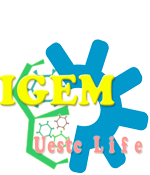From 2013.igem.org
First Model
Our first model explored the change of intermediate product in multistep degradation of TCP. assume K1=1,K2=0.5,the reaction is TCP→2,3DCP+Cl^- ; 2,3DCP→A+Cl^-. Through matlab analyzing, the program was in the program bar.
Finally, the reaction curve was predicted. The result was similar to what we had got through experiment.

FIG. The blue line stands for TCP; Red line stands for 2,3-DCP; Green line stands for serial product after 2,3-DCP.
Program(click see details)
[x,y,z]=dsolve('Dx=-x','Dy=x-0.5*y','Dz=x+0.5*y','t');
x=simple(x)
y=simple(y)
z=simple(z)
Results:
x =-C2/(2*exp(t))
y =C2/exp(t) - C3/exp(t/2)
z =C1 + C3/exp(t/2)
As x=5 y, z=0
Results:
C1=10,C2=-10,C3=-10
x =10/(2*exp(t));
y =-10/exp(t) +10/exp(t/2);
z =10 -10/exp(t/2);
Final formula
x =5/exp(t);
y =10/exp(t/2) - 10/exp(t);
z =10 - 10/exp(t/2);
Draw:
t=0:0.01:5;
x =5./exp(t);
y =10./exp(t./2) - 10./exp(t);
z =10 - 10./exp(t./2);
figure
plot(t,x,'b')
hold on
plot(t,y,'r')
hold on
plot(t,z,'g')
Fitted curve:
Second Model
The second model grade Linker and predict optimal length of linker in chimeric protein. According to many papers, the effects of linker length on equilibrium stability arise from significant and sometimes opposing changes in folding and unfolding kinetics.[1,4,7,8] As for the structure, the rank of linker is α-helix >β-sheet > loop.[2,3,4,5,8] And the effect of structure is dominant. We collected amass of data1,[4,6,7,8] and degraded the effect of linker. Finally, we got a formula. The formula can predict the efficiency of the length of linker. The full mark is 10 points.
Length points

y=y0 + (A/(w*sqrt(PI/2)))*exp(-2*((x-xc)/w)^2)
Y0=4.19829; Xc=21.97825; W=13.10889; A=68.84675
Structure point
1.α-helix A
2.β-sheet B
3. loop C
Results
The point of P2A is A, the length point is 7.9777
P2A is in high score in this system.
It is similar to our experiment result.
Predict
The optimal linker is an α-helix and the number of amino acid is 22. So in future work we can construct new chimeric protein using this linker.
Reference(click)
1. Robinson CR, Sauer RT. Optimizing the stability of single-chain proteins by linker length and composition mutagenesis. Proc Natl Acad Sci USA 1998;95:5929 –5934.
2. Ryoichi Arai, Willy Wriggers,Yukihiro Nishikawa,Teruyuki Nagamune,land Tetsuro Fujisawa.Conformations of Variably Linked Chimeric Proteins evaluated by Synchrotron X-ray Small-Angle Scattering.PROTEINS: Structure. Function. and Rioinformatics 2004;57:829一838.
3. Willy Wriggers,Sugoto Chakravarty,Patricia A. Jennings.Control of protein functional dynamics by peptide linkers.Wiley InterScience (www.interscience.wiley.com) 2005;DOI 10.1002.
4. Jianhua Zhang,Jun Yun, Zhigang Shang,Xiaohui Zhang , Borong Pan .Design and optimization of a linker for fusion protein construction.Natural Science 2009 ;1197-1200.
5. Patrick Argos.An investigation of oligopeptides linking domains in protein tertiary structures and possible candidates for general gene fusion.J. Mol. Biol 1990;211, 943-958.
6. Ekterina Minskaia and Martin D.Ryan.Protein Coexpression Using FMDV 2A Effect of "Linker" Residues.BioMed Research International 2013;Article ID 291730
7. Lynne Regan. Protein redesign(1999). Current Opinion in Structural Biology. IDO:ISSN 0959-440X.
8. BOOK: Stefan R. Schmidt . Fusion Protein Technologies for Biopharmaceuticals: Applications and Challenges



 "
"

